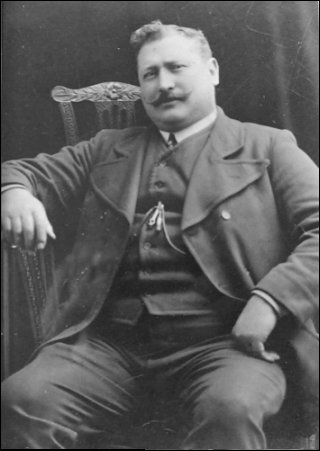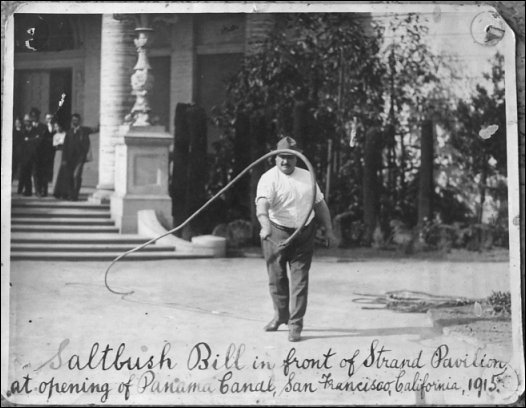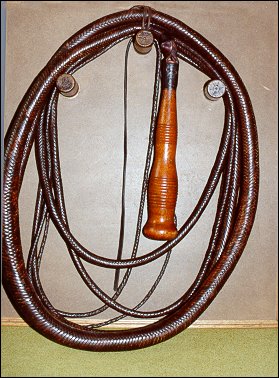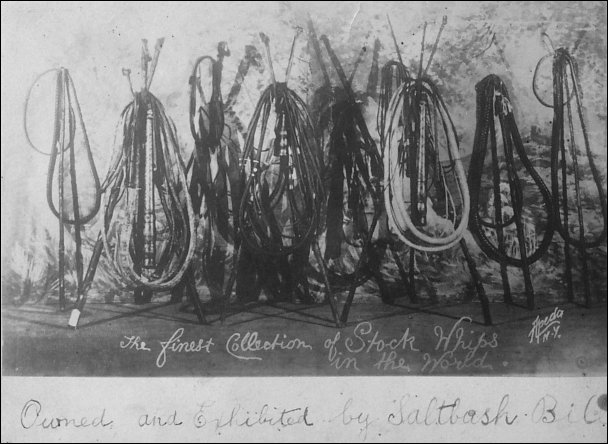Saltbush Bill: Stockman, Market Gardener and Entertainer Entertainer

Roderick William Mills known as Saltbush Bill.
A B (Banjo) Paterson, an icon in Australian literature used Saltbush Bill as the subject for several of his poems. Banjo portrayed Saltbush as a man prepared to fight for what he considered his rights while at the same time being a person who derived great enjoyment in out thinking the opposition. A drover who was concerned with finding feed for his sheep in times of drought and an individual who battled with the squatters who wanted to protect their pasture from his marauding flock.[1]
The subject of Banjo Paterson’s creativity was a real person, Roderick William Mills who lived with his family for many years in Heatherton. As an adult Roderick Mills was six feet two inches in height and weighed sixteen or seventeen stone. He could crack a whip up to 60 feet long with one hand, a measure of great strength. [2]

Saltbush cracking whip San Francisco, California 1915.
Born at Balnarring in 1869, Roderick William Mills earned the title of Saltbush Bill as a fourteen year old earning an adult wage working on a cattle station in Queensland. He was an excellent horseman, able to cope with long rides so he was always out in the saltbush whenever the property owner wanted to speak with him. As a result the owner called him Saltbush Bill and the name stuck.
A Melbourne saddler, J. K. Jennings put up £100 challenge that no man could crack a 65 foot stock whip held in his shop in three tries. Saltbush took the cash in his first attempt and immediately decided there was good money to be made out of this bushman’s craft which he had learned on long droving trips from Queensland. He decided to join show business.
In 1901 the Duke of York visited Australia to open Australia’s first Federal Parliament. Saltbush Bill, already an established personality, was invited to give a performance at Government House. The Duke was so taken with the act that he requested Saltbush to call on him should the whip cracker ever reach England.
With a growing reputation Saltbush Bill found himself with offers from overseas booking agents. In 1912 he joined Circus Sarrisani to tour England, Ireland, Scotland, Holland, Sweden, Norway, Denmark, India, South Africa, North and South America and New Zealand. On his second tour of England he received a Royal Command to perform at Buckingham Palace before King George V, whom he had met in Australia as the Duke of York, eleven years previously.
He appeared before the Royal family in typical Australian dress including jack boots and breeches, a scarlet shirt and muffler to give a whip cracking exhibition in the ballroom supper room and later a boomerang display in the gardens of the palace.
After some preliminary cracks of the whip, he called in a pretty female assistant from whose fingers he struck lighted matches, he cut cigars and cigarettes from her mouth and repeated the act with cigarettes held in his own mouth. Bigger and better whips were produced and holding one in either hand he wrapped them around the assistant’s waist, then her neck without marking her tender hide. The afternoon entertainment was concluded when Saltbush cracked out several bars of ‘God Save the King’ on his 65 foot whip. To mark his personal satisfaction the King presented Saltbush Bill with a gold tie pin in the form of the royal cipher set with rubies and diamonds.

The tie pin presented to Saltbush Bill by His Majesty, King George V.
The Prince of Wales accepted a stock whip from Saltbush Bill, and also the advice that by cracking it every morning His Royal Highness would acquire an agreeable development of muscle. Thanks to the example of the Prince the idea prevailed that whip-cracking before or after breakfast was a fashionable diversion and exercise. Saltbush Bill was of the view that whip-cracking as a healthy exercise, couldn’t be beaten. "Every muscle of your body is brought into play, and so are all your senses. It is practice for your ears and your eyes for your mouth, which quivers with involuntary expressions, and certainly for your nose, in keeping it out of the way." [3]
Following the Royal Command performance he visited South Africa, Canada and the United States working with Barnum & Bailey and Happy Harry Salman of Circus Fame. He served with the U.S. Mercantile Marine when he was caught in United States of America by the 1914-1918 war.
While in Canada Saltbush Bill told a reporter from the Daily News-Advertiser, that whip cracking, "is not an easy thing to learn, and not a little dangerous while you are learning tricks with it. Why, when I was practising knocking the ash off a cigar in my own mouth, I almost flayed all the skin off my face, and as you see, I am covered with scars from unexpected lashes. I have seen a duel fought by two stockmen with whips, and at the end they were dreadful objects to look at. Their flesh was cut in ribbons and many parts of their bodies." [4]

One of the whips made by Saltbush Bill.
During his career Saltbush Bill appeared at the Luke Grand Theatre, the London Hippodrome, the Theatre Royal, Barnum & Bailey Circus, Ringling Bros Circus, the London Opera House and during the 1914-1918 war he gave many exhibitions for charitable organisations to raise money for the war effort. He gave an exhibition for the Red Cross at the Eureka Hall, Windsor, England when £800 was raised, a massive sum for those times. His last concert was given in the Boomerang Hall in Dandenong in 1926.

Advertisement for Saltbush Bill’s appearance at Dandenong.
Prior to these overseas exploits Saltbush Bill married Hannah Louise Porter and conducted a market garden in Old Dandenong Road Heatherton. It was there that they raised eleven children All attended Heatherton Primary School. [5] He died in 1940 aged seventy-one while living with his two sons Jim and Johnnie Mills in Chandlers Road Dandenong. His wife had died nine years earlier. Roderick Mills was a great entertainer and a fine ambassador for Australia.

Saltbush Bill’s Whip Collection [6].
Footnotes
- The exploits of Saltbush Bill as a drover and bushman were the basis of several poems by A B (Banjo) Paterson. "Saltbush Bill", "Saltbush Bill. JP", "Saltbush Bill’s Gamecock", "Saltbush Bill’s Second Fight".
- Saltbush Bill was listed in the Guiness Book of Records for cracking the longest bullock stockwhip in the world.
- The Daily News-Advertiser, Vancouver, British Columbia, Friday September 17, 1915.
- Ibid.
- School Register, Heatherton State School 1894 -1918.
- At the end of his career Saltbush Bill had a collection of some 150 whips, the biggest of which was the National Anthem instrument. This whip was 65 feet long and weighted 28 1/2 pounds. His favourite whip was 56 feet long and weighed 23 pounds. It took two bullock hides and three days of consistent work to make. Today only two whips from the collection are held by the family. In an interview with the Canadian Daily News - Advertiser Saltbush is recorded as saying, "The whips I give exhibitions with are not all working whips. Several are show whips. Twenty feet would be an extreme length for a drover’s stock whip; in some of my feats of dexterity I use whips fifty feet long and over, and I’ll guarantee I could kill any sort of a wild bullock with such a whip, and face a tiger, even, for that matter. To the man who learns how to use it a stock whip is about as nasty a weapon as he can well possess, and it requires very careful making."
- Sylvia Roberts is the grand-daughter of Roderick William Mills known as Saltbush Bill. This story is based upon newspaper cuttings, posters, letters and reviews contained in a scrap book made by her grandfather.
